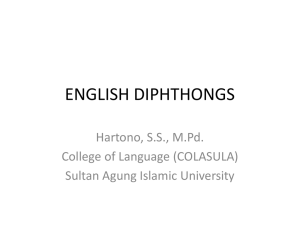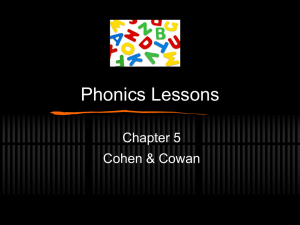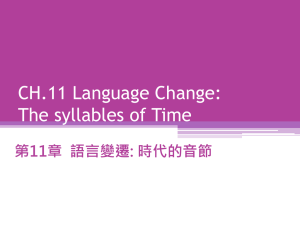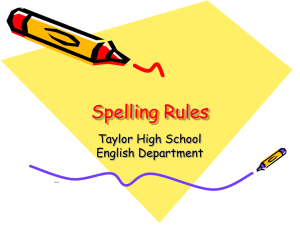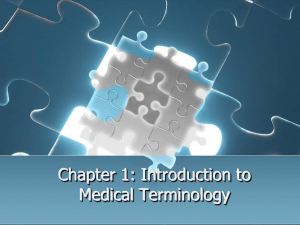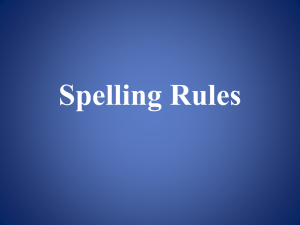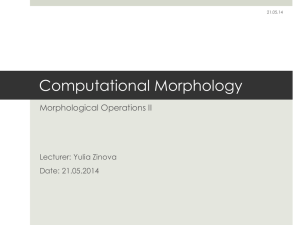training
advertisement
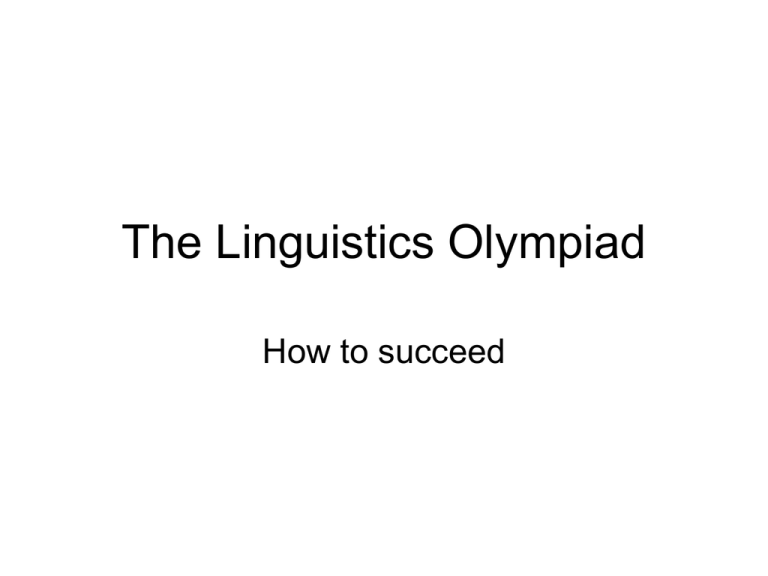
The Linguistics Olympiad How to succeed Some general principles • Trust the problem-setters! – Every problem is solvable. • Look carefully! – The fine detail matters. • Build on what you already know! • Don’t give up! Know yourself! • Can you hold information in memory? – If not, make notes. • Can you see patterns intuitively? – If not, work systematically. • Do you normally focus on details? – If not, keep checking details. • Can you easily think globally? – If not, keep checking the global picture. Levels of difficulty • Foundation level – Patterns are fairly obvious • Advanced level – Patterns appear only indirectly – Explanations are needed • International level – Patterns are barely visible – Explanations are central Foundation level: Abma Mwamni sileng. He drinks water. Nutsu mwatbo mwamni sileng. The child keeps drinking water. Nutsu mwegau. The child grows. mwamni, sileng = drinks/drinking or water nutsu = the child mwatbo = keeps mwegau = grows Patterns • Look for similarities between examples – repeated words – similar-looking words in similar orders. • Look for paired similarities (‘correlations’) – a pair in Abma linked to a pair in English. • Make bold guesses – you can abandon them if they’re wrong. • Turn uncertainty into a question. – e.g. Is ‘water’ mwamni or sileng? ‘Water’ = mwamni or sileng? Nutsu mwatbo mwegalgal. Mworob mwabma. Mwerava Mabontare mwisib. Nutsu mwatbo mwegalgal. Mworob mwabma. Mwerava Mabontare mwisib. Mabontare mwisib. Mweselkani tela mwesak. Mwelebte sileng mwabma. Mabontare mworob mwesak. Sileng mworob. sileng = water The child keeps crawling. He runs here. He pulls Mabontare. The child keeps crawling. He runs here. He pulls Mabontare down. Mabontare goes down. He carries the axe up. He brings water. Mabontare runs up. The water runs. mwamni = drinks/drinking Focus your work! • Focus on what the test actually asks for. – Don’t waste time on words you don’t need! • Focus on: – word endings (or beginnings), or any other changes of form – word order – But expect differences between languages • e.g. mwamni = drinks or drinking. Summary • Analysis: Break down the data. – Find the ‘bricks’ (words or word-parts) and how they fit together – Find the ‘underlying system’ • how the language works • i.e. its grammar • Synthesis: Build up your answers. – Use the bricks according to the grammar A harder problem: Turkish ikbalsiz isimsiz sonsuz takatsiz sütsüz parasız NB No dot!! unsuccessful nameless endless lacking strength lacking milk cashless Question: Here are two more Turkish words: dil (language), kalıp (form, shape). How would you translate (a) mute (b) shapeless? Link the question to the data • Analyse the data – to find patterns relevant to the question • So first analyse the question – What links ‘mute’ and ‘shapeless’ to: • ‘language’ and ‘form, shape’ • the basic data? • Answer: – ‘Mute’ = lacking language – ‘Shapeless’ = lacking form/shape. – All the data words mean ‘lacking something’. Your challenge • Find the word-part that means ‘lacking’ • Work out how to decide its form. – NB pay attention to detail: ‘i’ or ‘ı’? • Apply this rule in building your answer. • State the rule in as general a form as you can. ‘lacking’ = siz, suz, … ikbalsiz isimsiz sonsuz takatsiz sütsüz parasız unsuccessful nameless endless lacking strength lacking milk cashless Why does the vowel keep changing? A nasty twist • Two of the words don’t follow the regular pattern. – because they’re borrowed from another language. – BUT we don’t know which two! • So you’re looking for a rule that – explains most of the cases – that (hopefully) makes sense – but that doesn’t apply to two of the words. • So you have to look globally for a general trend – and hope the exceptions will stand out. Form or meaning? • What kind of rule are you looking for? • Based on meaning? – e.g. concrete/abstract? human/non-human? – Try it. • Based on form? – e.g. preceding consonant? – number of syllables? – anything else? (Think sideways!) – nearest vowel! Isolate the vowels isimsiz i–i ikbalsiz takatsiz sonsuz sütsüz parasız ü-ü Take the hint • Two vowel-pairs give a strong hint: – sütsüz: ü – ü – isimsiz: i – i • Towards a rule: the suffix is ‘s + Vowel +z’, where the vowel is: – i after i – ü after ü • More simply (and better): – the vowel of the suffix is the same as the vowel before it. Spot the two exceptions! isimsiz ikbalsiz takatsiz The only two words with the same pattern i–i a-i the exceptions? sonsuz o-u sütsüz ü-ü parasız a-ı The only suffix vowel found after two different vowels. But what about the other words? isimsiz i–i ikbalsiz takatsiz a-i sonsuz o-u sütsüz ü-ü parasız a-ı OK exceptional OK Why o-u, a – ı? Any information given is probably relevant! • e.g. this explanation: – e, i are like in pet, pit, with the lips spread. – ö and ü are like e and i, but with the lips NB ‘o’ and ‘u’ are in the same rounded. group. – o and u are like pot and put, with the lips rounded. – a and ı (NB: no dot) are like o and u, but with And so are ‘a’ and ‘ı’. the lips spread. Tweaking the rule • The rule so far – The vowel of the suffix is the same as the vowel before it. • Relaxing the rule to include o-u, a – ı – The vowel of the suffix is similar to the vowel before it: • for ‘i’ and ‘ü’ it’s the same vowel • for ‘o’ and ‘a’ it belongs to the same group. Try to understand • If a form varies, ask: – What influences it? – Why is it influenced by that? – Why in this particular way? • Don’t assume that everything is driven directly by meaning. • Think of an apple but a pear. An advanced problem: Tangkhul • Structure of problem: – 9 sentences in Tangkhul – 9 sentences in English that translate them. – but in a different order! • Challenge: – Work out which E sentences translate which T sentences – and which E words translate which T words! For instance • Tangkhul: – (a) a masikserra. – (b) āni masikngarokei – (c) āthum masikngarokngāilā • English: – (1) Do they want to pinch each other? – (2) Do you(sg) see it? – (3) Have you(pl) all come? Getting started • Use any clues you can find. – The vital clue will probably not be obvious and may seem trivial. • Look for trivial patterns in the data – length of words – number of words – names – recognisable foreign words – numbers What do you see? (a) a masikserra. (b) āni masikngarokei (c) āthum masikngarokngāilā • number of words per sentence – two • length of words – short - long Which is the odd one out? (d) ini thāingarokei (e) na thāilā (f) ithum thāingāihāirara (g) rāserhāira (h) āni rāra (i) nathum rāserhāiralā Just one word! And here? 1. Do they want to pinch each other? 2. Do you(sg) see it? 3. Have you(pl) all come? 4. He/She will pinch all (of them). Missing subject! 5. (They) all have come. 6. They(du) pinched each other. 7. They(du) will come. 8. We(pl) will have wanted to see it. 9. We(du) saw each other. So maybe … • (g) rāserhāira = 5. (They) all have come. • The short words are subject pronouns – e.g. They, you • rāserhāira means ‘all have come’. – a complicated meaning which may be signalled by complicated parts • What are the parts of rāserhāira? – look for other words with similar parts. You’ve got your crucial clue! • When you look for word-parts, you’ll find them. • Work out how word-parts combine – including their order within a word. • Use all this information in producing your own translations. Good luck! • And enjoy the fun of combining: – Sherlock Holmes – Sudoku – Language learning

